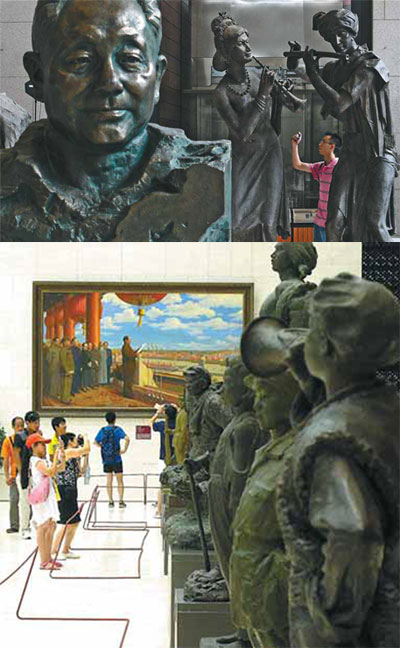
 |
|
Top and above: The newly renovated National Museum of China has held more than 50 large-scale exhibitions over the past year. One of the latest shows is Chinese Sculptures in 100 Years. Photos by Jiang Dong / China Daily |
Related: Timeline, Time capsule of a country's past
The newly renovated National Museum of China mirrors the country's peaceful rise, according to Zhu Linyong.
A 2.5 billion yuan ($393 million) renovation project has turned the National Museum of China into the world's largest museum. And since the trial opening in March 2011 it has captivated the public. "It has quickly become a new, cultural icon and key attraction for tourists to the Chinese capital, thanks to its brand-new look, enlarged and re-engineered structures, rich exhibits and services that keep upgrading," says museum director Lu Zhangshen. The museum celebrated its 100th birthday on Monday.
"We're trying our best to put it among the world's best museums," Lu says.
The renovation and expansion project was in answer to calls to better present the country's history over the last century, as the country's influence continues to grow.
The museum began soliciting bids for plans from international architects in 2004. Ten projects were short-listed.
Approval was given to a plan from the Institute of Building Design under the Chinese Academy of Building Research and the German design company Gerkan, Marg and Partners.
"There were inevitable arguments and differences among Chinese experts, officials and foreign architects," recalls Wang Jun, director of Institute of Building Design.
For instance, the German company proposed covering the existing building's courtyard with a "floating" bronze roof to create an interior public square. But that idea was nixed.
"Our exchanges were open and direct," Gerkan, Marg and Partners architect Stephan Schuetz says.
"Different cultural backgrounds generate different views on the same subject. But we all felt it was not an obstacle to this project."

Schuetz - along with Meinhard von Gerkan and Stephan Rewolle - played a key role in revising the bid-winning design.
"The biggest challenge was to create a dialogue between the old building from 1959 and the extension project, which finally tripled the original floor area," Schuetz says.
Most Chinese experts suggested creating a more harmonious interaction between the existing parts and the renovated and extended parts.
"That was the reason we were asked to revise the design," Schuetz adds.
The State Council finally approved the plan in 2006. Renovation and expansion started on March 17, 2007 and finished before the end of 2010. On March 1, 2011, the new museum began a yearlong trial operation.
About 42 meters high, the newly renovated and expanded museum includes four stories above the ground and one floor underground that are open to the public.
To bring out the best for visitors, the museum has undergone painstaking design and decoration work both for its facade and interiors, says the museum's deputy director Du Haijiang.
As a result, the decor has a strong Chinese flavor.
The museum's facade looks almost the same as the one built in 1959 and hence is in harmony with other constructions around Tian'anmen Square.
While the older parts of the traditionally fashioned up-turned eaves are made of glazed tiles, the expanded parts are made of metal but hand-painted, so as to be in sync with the older ones in tone, Du explains.
The decor for the museum's interior is in gray and wood tones and fashioned out of stone, wood and metal.
The rooftop contains 368 translucent caisson ceilings, often used in traditional architecture, for lighting and ventilation purposes.
In the western hall, viewers will find on the upper part of the gate to the central hall, sculptor Zeng Chenggang's marble relief work, Foolish Grandpa Moves the Mountain, inspired by Xu Beihong's 1940 ink painting.
The "Foolish Grandpa" story comes from a fable that eulogizes Chinese people's persistence in the face of obstacles. The work, 36 meters long and 12 meters high, is the largest indoor relief work in the country.
On the walls of the second and third floors, viewers will find huge murals that depict all of China's ethnic groups.
Also deserving of mention are four VIP lounges for State guests on the third floor above the central hall, says Zhang Qiman, the chief supervisor for the museum's interior decorations.
They are the Wood Carvings Lounge, the Brick Carvings Lounge, the Bronze Carvings Lounge and the Stone Carvings Lounge, reflecting four major genres of traditional craftsmanship.
For instance, woodcarving craftsman Lu Guangzheng from Dongyang, Zhejiang province, has created sandalwood carvings with traditional motifs for the Wood Carvings Lounge.
Liu Yiming, a master brick-carver from Suzhou, Jiangsu province, has created gold brick carvings with imagery of gardens in southern provinces.
Bronze carving master Zhu Bingren has created wall-hanging decorations for the Bronze Carvings Lounge and the motifs are inspired by inscriptions on the surface of the Hou Mu Wu Rectangular ding vessel, one of the museum's best known treasures.
On the fourth floor is the White Jade VIP Lounge. About 830 square meters in size, the lounge, decorated with glass, can accommodate at least 10,000 visitors for a meeting or banquet.
"The design and decorations in the museum rightfully mirror the highest level of artistry in arts and crafts today," Zhang says.
Over the past year, the museum has received more than 4.1 million visitors from home and abroad.
"The new museum has won accolades from visitors and experts," museum director Lu says. "It's a monumental structure that symbolizes an upgrade in China's soft power."
Contact the writer at zhulinyong@chinadaily.com.cn.